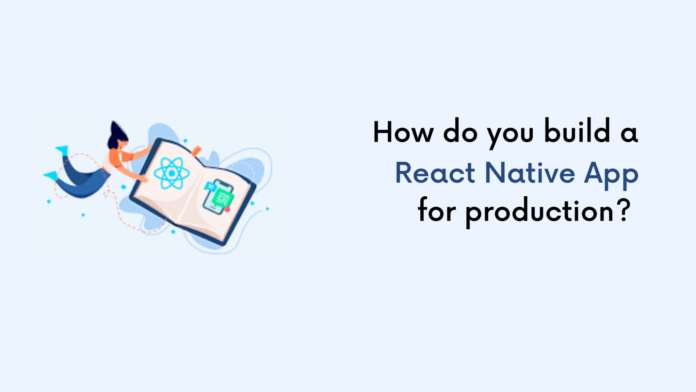React Native is one of the most popular mobile app development platforms that help the creation of functional apps. The creation of apps for organizations can take three to nine months for production as per its complexities. Getting the production-ready apps means acquiring the best version of the app to be ready for use. The production-ready app is the common term used in mobile app development. The app needs to meet the demands of the business and thus take the help of React Native app development experts for quick assistance.
The development of production-ready apps using React Native is a specific art completed by software developers. As mobile users are accustomed to best-quality apps, it is important to get functional apps for release in the market. Take the help of top-rated app developers to build a React Native app for production. The blog highlights details and steps related to the building of a React Native app for production.
Brief about Production-Ready Version of Apps Using React Native
An app or piece of software is production-ready if it meets the demand of the business or its clients. It includes the ease of usability and availability as per the need. The experts are assessing the criteria in multiple ways, but Agile Teams rely on user stories to validate usability and automate testing for readability validation. The software needs to be available for simple use and the Agile Teams maximize the availability by leveraging the continuous delivery practice.
The size of the software also matters in developing production-ready software for organizations. It is easy to assess a small piece of software and thus can be released quickly. This means that the deployment is easy and thus the app provides instant value. The release of the software can be evaluated the same way and thus ensure that the tool is production-ready & with minimum delays. The React Native app development expert can assist you with production-ready versions of apps using React Native.
Developing a React Native App from Scratch
To start the development of an app using React Native, you need some prerequisites like Android Studio, Android Emulator, an Android device, a text editor, node, npm, and npx.
Follow the simple steps –
- Start with running a command in the terminal –
npx react-native init rnProduction
- Now open the project inside the IDE and start the development environment by running the following commands –
npx react-native start
- It is time to run the app on the Android emulator or Android phone using the command –
npx react-native run-android
- You will receive the message ‘Welcome to React Native’, after running the application for the first time.
Creating Developer Version 0.0.1 of the App
The section includes the development of the MVP version of the software and it will be done by rendering the app inside App.js. file. Let us follow the steps –
Import ‘package.json’ to render the version of the app:
import packageJson from ‘./package.json’
Now the React Native app development expert can do the necessary styling of the app as preferred and it will be done.
Build a Production-Ready Version of the App for Android
The building of production-ready apps involves some vital steps and we’ll discuss them in this particular section. You need to be aware of some of the common terms before starting with the development steps. Let us look at them –
Android Keystore System: It allows the storing of cryptographic keys in a container named ‘Keystore’.
Android Keystore: It is the container for authorizing the public key or authorization certificates. These are used by Java-used apps for authentication and encryption.
Debug Keystore: It is the Keystore used for signing an Android Package and is generated for the build tools. The Keystore is assisting to run an app on the emulator connected to the device via a USB.
Android Package: It is the packaged file format used by the Android systems for the installation of mobile apps, games, and middleware.
Signed Apk: It is referred to as the Android package file that holds the private key for developers. The device is not installing the APK that is not signed properly.
Gradle: It is the build system used for the compilation of codes, deployment, testing, and maintenance.
Generation of the Right Release Key
A key tool is used for the generation of release keys and it is advisable to get a relevant tool before the start. Run the command –
Keystore name: ‘release-key.keystore’
Key alias: ‘rnProduction-key’
Next, enter the key and the password as when asked. Always remember the Keystore file name, alias, Keystore, and passwords for setting up the Gradle variables.
Finally, get the right details like first & last name, location, country code, and others. The Keystore file is placed smoothly inside the project root after generating the project folder.
Setting Up Gradle Variables
Gradle is referred to as the build system for compiling, testing, deployment, and other activities. It will require relevant information for the completion of the build.
Supply Gradle with the following keys for the property keys –
MYAPP_UPLOAD_STORE_FILE=release-key.keystore
MYAPP_UPLOAD_KEY_ALIAS=rnProduction-key
MYAPP_UPLOAD_STORE_PASSWORD=your-password
MYAPP_UPLOAD_KEY_PASSWORD=your-password
Add Sign Config in App’s Gradle Configuration
The SigningConfig debug is automatically generated by the build tool. Developers need to make relevant changes to the signingConfigs & buildTypes by adding the release build and pointing of build type to the release build.
Release {
If (project.hasProperty(‘MYAPP_UPLOAD_STORE_FILE’)) {
storeFile file(MYAPP_UPLOAD_STORE_FILE)
storePaddword MYAPP_UPLOAD_STORE_PASSWORD
keyAlias MYAPP_UPLOAD_KEY_ALIAS
keyPassword MYAPP_UPLOAD_KEY_PASSWORD
Generate a Release APK
It can be done by changing the directory into the Android key as ‘cd android’. Now Run the command ‘./gradlew assembleRelease’ to bundle the application into the apk file.
Test the Release Build of the Software
It is possible to test the build production of the app by running the command – ‘npx react-native run-android –variant=release’. But, the initial need to be related to debugging the software from the device it is running.
Final Thoughts!
Organizations invest heavily in apps to get the best returns. Focusing on small production-ready releases can help the software become competitive. The content above guides you with the building process of a react native app in detail. Reach out to React Native app development experts for the best assistance in building a React Native app for production. Developers need to be aware of the building process before committing to the creation of apps with the relevant platform. Create the right kind of app with help of software developers to boost the business profits.















